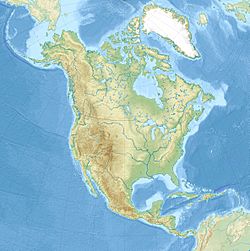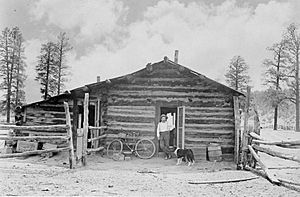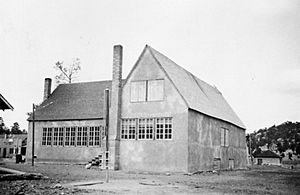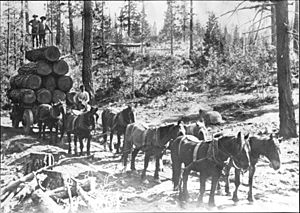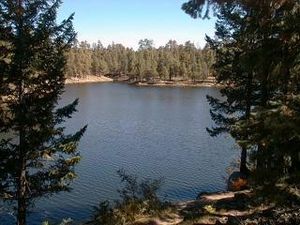Heber-Overgaard, Arizona facts for kids
Quick facts for kids
Heber-Overgaard, Arizona
|
|
|---|---|
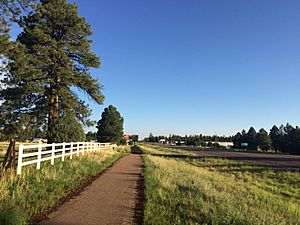
Central Heber-Overgaard viewed from SR260
|
|
| Motto(s):
"Always In Season"
|
|
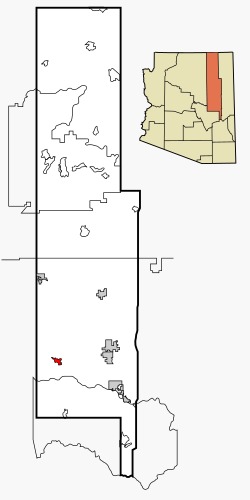
Location in Navajo County and the state of Arizona
|
|
| Country | |
| State | |
| County | Navajo |
| Settled | 1883 |
| Established | 1890 |
| Government | |
| • Type | Unincorporated |
| • Body | Navajo County Board of Supervisors |
| Area | |
| • Total | 6.86 sq mi (17.77 km2) |
| • Land | 6.86 sq mi (17.77 km2) |
| • Water | 0.00 sq mi (0.00 km2) |
| Elevation | 6,627 ft (2,020 m) |
| Population
(2020)
|
|
| • Total | 2,898 |
| • Density | 422.45/sq mi (1,094.14/km2) |
| Demonyms | Heberite, Overgaardian |
| Time zone | UTC−7 (MST (no DST)) |
| ZIP Codes |
85928, 85933
|
| Area code(s) | 928 |
| FIPS code | 04-32310 |
| GNIS ID(s) | 2408368, 29842, 32586 |
| Major airport | Mogollon Airpark |
| State Routes | |
Heber-Overgaard is a census-designated place (CDP) in Navajo County, Arizona, United States. Situated atop the Mogollon Rim, the community lies at an elevation of 6,627 feet (2,020 m). The population was 2,898 at the 2020 census. Heber and Overgaard are technically two unincorporated communities, but as of the 1990 census, their proximity led to the merged name of "Heber-Overgaard".
Heber was settled in 1883, by members of The Church of Jesus Christ of Latter-day Saints (LDS Church), and the town is named after either Heber J. Grant or Heber C. Kimball, both prominent members of the LDS church. Overgaard, adjoining Heber, was settled c 1936 and was named after the owner of the first sawmill, Niels Kristian Overgaard.
Heber-Overgaard's early economy was founded on dry farming and ranching while tourism, retirement and timbering are the basis for present day industry.
Contents
History
Founding
In March 1873, Mormon pioneers from Utah were sent to the Little Colorado River area under the direction of Horton D. Height. In 1876, a large group of these settlers established four settlements on the Little Colorado River, which they named Brigham City, Sunset, Obed and Allen's Camp (Joseph City). In Allen's Camp, a dam had been built on the Little Colorado River in April, but high waters in July washed it out. By August, many settlers had returned to Utah. Eight married couples and six single men were all that remained in Allen's Camp. By 1882, the Obed settlement had collapsed and both Brigham City and Sunset were near collapse due to several years of drought. At this time, John Bushman, of Allen's Camp, was sent by Lot Smith, then president of the Little Colorado Stake, to scout the forests to the south in anticipation of relocation. Dry farming in the forested mountains was thought to be easier due to higher rain fall, lush grasses, and plentiful timber.
On December 6, 1882, Bushman set out for the forest with five brethren: W.C. Allen; J.H. Richards; J.C. Hansen; H. Tanner; and J.E. Shelley. Upon arrival they began digging wells in search of water. These men were later joined by Hans Nielson, Lehi Heward and John Scarlet. By April 13, 1883, two cabins had been built and grain planted, but only four families remained (Lehi Heward, John Scarlet, Hans Nielson, and James Shelley). John Bushman never settled in the area, but he and his family contributed time and encouragement to the local settlers. The first summer, houses were built, land cleared, and corrals constructed. Crops were planted not only for food, but also to barter for goods that could not be made at home. The growing season was four months long.
In 1887, Lehi Heward abandoned the settlement and relocated to Pine, Arizona. He was urged to do so, because of the Pleasant Valley War. Buckskin Canyon, where he had settled, was named after the buckskin chaps his wife Elisabeth had made for him. John Scarlet was next to leave in 1888. His wife Lulu had become ill in June 1885. This may have contributed to his subsequent departure. In 1887, he was mentioned to have joined the posses of Joe McKiney's, under-sheriff for C.P. Owens. In 1889, Nathan, Alva, and Samuel Uriah Porter, arrived in Heber from St. Joseph (Joseph City). They grew crops of corn and potatoes between Heber and St. Joseph. The following year brought the Penrod and Sharp families from nearby Wilford. Samuel Porter would later describe the Penrods as anti-Mormon, and the Sharps as dishonest. In 1898, Hans Nielson abandoned his estate on the west bank of the Black Canyon were today's HW260 enters town. Childless, Hans Nielson had been the first presiding elder for what became the Heber branch of the Joseph City Ward. James Shelley homesteaded land comprising the center of Heber and south down the Black Canyon. Of the original four pioneer families, starting out with four head of cattle, three daughters, and a few worldly possessions, James and Margaret Shelley were the only family to make Heber a long term commitment.
Early Heber
In 1882, Heber J. Grant was called as a member of the Quorum of the Twelve. Early on in his service in the quorum he made many trips to Arizona earning the title "The Arizona Apostle". On one such trip, he passed through the settlement on his way to Phoenix, and stayed with the Shelleys in their cabin. The townspeople latter named their settlement after Mr. Grant.
An alternative version of Heber's namesake history is that John W. N. Scarlett named the settlement after Heber C. Kimball, former Chief Justice of the State of Deseret.
The post office in Heber was established in 1890, and on September 11, 1890, James Shelley was appointed the first postmaster of Heber. Mail was brought by buckboard every Wednesday from Holbrook to Heber. It was then sorted and distributed. This duty was performed by James Shelley, in addition to being a farmer, cattleman, husband and father.
Marion and Clarence Owens came to farm in Heber with their families in 1891. The following year, two practicing polygamists arrived from Utah to escape prosecution. One was called "Brother Luck". In 1893, Joseph Porter arrived in Heber to help his brother, Samuel Porter, with his farm. Also in 1893, John Nelson occupied a ranch in Brookbank Canyon, and the Baca family had settled near the head of Black Canyon. John Nelson and partner, Nicholas Valentine, were in the sheep business, and the Porters hauled their wool to the Holbrook railroad. Nicholas Valentin died four years later from a rabies bite acquired from a skunk.
Many settlements were located in the fertile cattle ranching and farmlands of Black Canyon. Potatoes, corn, milk, eggs and large gardens were the livelihood of many families. Potato fields could be found down Buckskin Canyon, near the present day "Buckskin Artist Community". Cornfields and large gardens could be found where the present day High School ball fields and Tenney's Trailer Park are located. All available land near town and in forests clearings was converted to farmland. Wilford, Jersey Gulch, Baca ranch and present day "Potato Patch" were favorite locations.
During this time period, locals were fearful of the Apaches. Food was said to be given out to any natives, passing through town, in order to "keep the peace". At this time, travel to and from St. Joseph was sometimes perilous due to outlaws and quicksand. Horses were the primary mode of transportation, and horse thieves were a major problem.
On August 28, 1895, Joseph Porter and Mary Maude Shelley were married. Many present day Porters, of Heber-Overgaard, can trace their family roots to them. In 1896 Samuel, Alva and Nathan Porter divided up their farm. In addition to farming, Samuel Porter was often called upon to administer to the residents of Heber to alleviate pain and suffering by using prayer and petitions. A drought affected the residents of Heber that Summer, followed by crop destroying hail storms in August. In January 1897, Wickliff Bushman, while delivering mail to Heber from Holbrook during a snow storm, contracted the measles and died at 23 years old. Three of Samuel Porter's children also contracted the disease, but survived. Margaret Shelley had twin boys that June, but only one son survived.
In 1891 John Hoyle, Johann Frederick Heil, an immigrant from Baden, Germany and former cook for the Hashknife Outfit, opened the first Heber store. He was called "Hoyle" rather than "Heil" because some cowboys had trouble pronouncing his name. In addition to his store he had a farm located down Buckskin Wash. John Hoyle had relocated to Heber from the failed Wilford, Arizona settlement, 7 miles south of Heber, where he had a store and ranch. Samuel Porter helped him on his farm, and hauled freight to and from Holbrook. He ran the store until his death on August 2, 1912 of paralysis (possibly polio). He had no heirs to claim the land in the United States. Through a German consulate, twenty-eight distant heirs were located and $3,046 was divided among them.
May 1898 was so dry that water was hauled from wells in Wilford for household use. Heber wells still had enough for livestock. A small reservoir had been built below town, and filled up when water ran down the Black Canyon. A diversion dam was built to divert water from the wash to the ditch. When the rains finally came in July, the Independence Day celebration had cause for additional celebration. Residents celebrated by firing guns, fire crackers, Pie Nie, and a dance that evening. Years later, The 4th of July would remain just as large a celebration in Heber. Alva Porter's Farm eventually became the rodeo grounds, where present day Mogollon High School sits. During celebrations, the community roped caves, rode bucking horses, held pistol shooting contests, foot races, and dances.
The 20th century
Alva Porter was married to Charlotte Shelly in 1899 and homesteaded just north of Heber in the Black Canyon. In 1901, Samuel Porter handed his farm over to his brother Alva, and departed from Heber. Porter's farm was located where today's Tenney trailer park, and the Mogollon ball fields stand.
In 1904, severe drought caused hundreds of cattle belonging to the Aztec Land and Cattle Co. to die from thirst and hunger. During the spring, drinking water had to be hauled from 15 miles away. Many pioneers became disheartened and left the area. In late June, James Shelly and 2 sons desperately drove their cattle to "Blue Lake", found on the Apache reservation. They remained there until the rains came on July 20. Despite trespassing, the natives gave them no trouble.
In 1912, after John Hoyle's death, Alva Porter purchased much of John Hoyle's merchandise and he and his brother-in-law Thomas Shelley started a new store close to John Hoyle's old one. Alva eventually sold his share to Thomas who ran the store with his wife, Eva Tanner, until 1957. The store would later become the "Heber Country Store" and later "IGA Supermarket".
In 1916, James, and Margaret Shelley returned to Joseph City, their final home. Three Shelley children: Sarah Ellen Shelley (husband Harvey Wimmer), Walter Shelley (wife Roxie Smith), and Eliza Marie Shelley (husband Loran Webb) joined them later. Two Shelley children: Amon Shelley (wife Elva Bigler), and John Edward Shelley (wife Fern Oliver), remained in Heber.
Joseph Porter and Maude Shelley were granted a patent on John Hoyle's land in 1920. They homesteaded this land located in Buckskin Wash, just south of the Black Canyon. Thomas Shelly homesteaded south of Joseph Porter in Buckskin wash. Maude Shelley would later die in 1929.
The Heber school district was established in 1921. Prior to this, children had to move to Joseph City in late fall, after crops were harvested, then return in early spring. The first year took place in Walter Shelley's house. Priscilla Shumway, from Snowflake, was the first teacher. A new schoolhouse was planned. James L. Porter (Dobby), grandson to Sanford Porter, donated 80% of the land towards the new school house located where today's Capps Middle School now stands.
By the 1930s, Heber had become a logging town. Horses were used to haul logs up until 1965. Logging and ranching were the predominant industries until the mid-90s, at which time the Mexican spotted owl injunction was put on the Sitgreaves National Forest. Bill Porter built the first sawmill in Heber just south of present-day HWY260 along the Black Canyon. This ran until 1935 when it burned down. In 1946 Lorin Donald (Donnie) Porter relocated his "Wagon Draw" sawmill to Heber. It ran until 1984 when a change of ownership was soon followed by bankruptcy.
In 1936, Niels Kristian "Chris" Overgaard, the second son of a Danish family, came to America to seek his fortune in the lumber mill business. He moved to Arizona from North Dakota, lured by the lush stands of Ponderosa. He had modular mill pieces transported by train to Holbrook, and then hauled by wagon to "Overgaard’s stop". Mr. Overgaard's sawmill was built across HWY260 from what is now the "Overgaard Market". He operated the mill until financial reversals prompted its sale. Seeking new opportunities, he then moved with his wife to Ohio, forever leaving the area. The mill was eventually replaced by the old Senior Center that was lost in the Rodeo–Chediski Fire in the summer of 2002. The Senior Center has since been rebuilt. Originally called "Oklahoma Flats", the town later changed its name in honor of Mr. Overgaard. The post office in Overgaard was established on October 14, 1938. William T. Shockley served as the first postmaster in 1938, followed by Christ Overgaard in 1939.
Upon moving to Heber in the 1950s, Mr. Brown Capps served as principal, and Mrs. Ella Capps as a teacher, of the Heber schoolhouse until his death in 1969. Capps Middle school gets its namesake from Brown and Ella Capps. In 1969-70, the Heber and Overgaard schools consolidated. Mogollon High School was built in 1989. It was named after the nearby Mogollon Rim. Mountain Meadows Primary School was built in late 1999.
On February 1, 1971, the local Sheriff's Posse formed a committee to promote the construction of a Fire Department for the Heber-Overgaard area. By March of the same year, land was secured for the location of the new Fire Department. In February 1972, the Sheriff Posse disbanded because some members had moved out of the area. In early 1973, the newly formed American Legion Post 86 took over the task of forming a Fire Department and Fire District for the area. They were able to obtain the signatures necessary to have an election called to form a Fire District. A petition was put together and used to propose the formation of a Fire District to the County Board of Supervisors. The American Legion put up the necessary funds to have an election. On June 4, 1973, by unanimous vote, the Heber-Overgaard Fire District was established. It had an area of 102 square miles. On June 14, Ivan Wilson was elected as the first Fire Chief of the new District and Larry Rhodes as the Secretary-Treasurer. Walt Downs and John Shaffery Sr. were the first two men to sign up as Firefighters.
The first 4 July parade was held in 1976.
On July 4, 1980, Les Parham, of Heber-Overgaard, put on his first of over 33 years of fireworks displays. Fundraising was spearheaded by the Heber-Overgaard Chamber of Commerce and was solely paid for by the contributions of viewers who enjoyed the show. The first show was held in what was once known as the Porter softball field, SW corner of Parkview and HW260, to an audience of several hundred. A country fried steak dinner fundraiser was held to cover expenses. Today, an audience in the thousands views the display at the Mogollon High School fields. This is primarily paid for by parking lot donations.
In 1988, Heber-Overgaard celebrated its first Oktoberfest event.
On August 24, 1995, federal Judge Carl Muecke ordered the 11 national forests of Arizona and New Mexico to halt all logging until their forest plans adequately protect the Mexican spotted owl. The injunction was placed after a lawsuit was filed by Robin Silver, conservation chairman of the Southwest Center for Biological Diversity. The controversial shutdown affected 8 large mills, several small mills and hundreds of jobs. Many Heber-Overgaard residents were forced to relocate and find work elsewhere. Black ribbons were placed throughout town to raise awareness of the situation, and to show support for the loggers and their families. Environmentalists argued that "jobs would vanish no matter what, for if cutting continued at its current rate, the old-growth forests would be gone within thirty years and the mills forced to close anyhow". The forests remained closed for over eight years. In 2002, the Parker Mill, in Clay Springs (16 miles away), and the Snowflake Mill (35 miles east) were two of the first mills to start up again.
The 21st century
In 2002, the Rodeo-Chediski fire was a wildfire that burned in Heber-Overgaard beginning on June 18, 2002, and was not controlled until July 7. It was the second worst forest fire in Arizona to date, destroying 268 structures in Heber-Overgaard, (mainly in Overgaard) and consuming 467,066 acres (1,890.15 km2). Overgaard was evacuated for nearly two weeks while the fire was fought.
Today, Heber-Overgaard has evolved into a retirement and tourism destination. Recreational and lifestyle activities such as hiking and fishing can be enjoyed in the summer, and cross country skiing in the winter. With a four-seasons climate, the town is a haven for those wishing to escape the heat of Phoenix. Land ownership in the Heber-Overgaard area is private, but surrounded by federally owned lands. As of 2010[update], nearly 66% of the houses are second homes. While the full-time resident population is 2,822, summertime population numbers climb to nearly 12,000.
Geography
Heber-Overgaard is located at 34°24′47″N 110°33′52″W / 34.41306°N 110.56444°W (34.413157, -110.564393).
According to the United States Census Bureau, the CDP has a total area of 6.9 square miles (18 km2), all of it land.
Climate
Heber-Overgaard has an atypical version of a Mediterranean climate (Köppen Csa) with a dry period in early summer followed by heavy monsoonal thunderstorms and rain from frontal cloudbands in the cooler months. Like more typical Mediterranean climates, however, forest fires tend to be extremely prevalent during dry summer periods.
|
||||||||||||||||||||||||||||||||||||||||||||||||||||||||||||||||||||||||||||||||||||||||||||||||||||||||||||||||||||||||||||||||||||||||||||||||||||||||||
Demographics
| Historical population | |||
|---|---|---|---|
| Census | Pop. | %± | |
| 1990 | 1,581 | — | |
| 2000 | 2,722 | 72.2% | |
| 2010 | 2,822 | 3.7% | |
| 2020 | 2,898 | 2.7% | |
|
|
|||
As of the census of 2020, there were 2,898 people, 1,350 occupied households (2,197 unoccupied), and 1,192 family units residing in the CDP. The population density was 422.45 people per square mile (1,094.14/km2). There were 3,547 housing units at an average density of 517.6 per square mile (1340.58/km2). Occupied housing units consisted of 2.3% without a bedroom, 8.6% with one bedroom, 83% with 2–3 bedrooms, and 5.5% with 4 or more bedrooms. Median gross rent was $691.
The racial makeup of the CDP was 1.7% American Indian or Alaska Native, 0.4% Asian, 0.4% Black or African American, 11.4% Hispanic or Latino, 0.2% Native Hawaiian or Pacific Islander, 83.8% Not Hispanic or Latino, 87.6% White, 3.7% from other races, and 6.0% from two or more races.
There were 1,350 households, out of which 16.5% had children under the age of 18 living with them, 45.2% were married couples living together, 29.1% had a male householder with no wife present, and 19.7% had a female householder with no husband present. The average family size was 2.96. Of 3,547 housing units, 2,197 were vacant. Veterans made up 20.1% of the population. Marital Status makeup for the CDP was 49.3% Married, 8.7% widowed, 19.2% divorced, 1.6% separated, and 21.2% never married. Population by age ranged with 2.4% under the age of 5, 9.3% from 5 to 14, 4.8% from 15 to 17, 16.5% under 18, 65% 18 and over, 34.4% 65 and over. The older population consisted of 19.3% 65 to 74, 10.2% 75–84, and 4.8% 85 and older. The median household age was 55.4 years.
The median income for a household in the CDP was $35,417, the median income for a family was $37,672, married-couple families was $37,961 and non-family was $26,858. About 22.3% of the population were below the poverty line, including 34.7% of those under age 18, 29.2% age 18–64, and 6.4% of those age 65 or over. 26.6% of the total population were on disability. The industry was made of 10.7% (Agriculture, Forestry, Fishing and Hunting), 12.3% construction, 24.4% retail, 4.4% (transport, warehousing, utilities), 4.7% information, 3.4% (finance and insurance, real estate, and rental and leasing), 4.4% (professional, scientific, and management, and administrative and waste management), 9.4% (arts, entertainment, and recreation, and accommodation and food services), 4.3% other services, and 1.5% public administration. Employment Rate was 33.8%.
Education attainment consisted of 32.1% with a high school or equivalent degree, 31.2% with some college (no degree), 8.8% with an associates degree, 11.8% with a bachelor's Degree, and 3.7% with a graduate or professional degree. The school enrolled population was 86.9% consisting of 0% preschool, 86.9% kindergarten to 12th grade, 13% college or undergraduate, and 0% graduate or professional degree.
Parks and outdoor recreation
Heber-Overgaard offers multiple community facilities including a library, 40-acre park, and many athletic facilities: baseball, football and Little League fields; basketball, volleyball, tennis and racquet ball courts; and a 9-hole regulation length golf course.
Immediately south of Heber-Overgaard is the Mogollon Rim, a steep escarpment ranging from 1,000 to 2,000 feet from the base to the highest plateau. The Rim divides the northern plateau region from the lower central and southern areas. The Rim offers scenic views and numerous man-made lakes ideal for fishing.
Hunting for elk, deer, turkey, antelope and bear is permitted. Fishing, in nearby trout streams, is popular. There are also picnic and camping facilities available within the area. Other scenic attractions in the area include Black Canyon Lake, Willow Springs Lake, Woods Canyon Lake, Chevelon Canyon Lake, the Canyon Creek Fish Hatchery, Chevelon Butte, and the Fort Apache Indian Reservation.
Nearest cities and towns
Economy
Retirement and tourism are an important part of the Heber-Overgaard economy. Proximity to the Sitgreaves National Forest provides recreational opportunities, and timber is harvested for Precision Pine Sawmill and Stone Container Paper Mill. A mulch plant processes forest by-products.
Service businesses provide employment and services for the predominant retirement community. Government and schools also contribute to the local economy. Retail trade is increasing. Construction is also a major factor in the area's gradually expanding economy.
Notable people
- Chester J. Crandell – Former Arizona State senator
- Jesse Horn – American author, illustrator and musician
Images for kids
See also
 In Spanish: Heber-Overgaard para niños
In Spanish: Heber-Overgaard para niños




